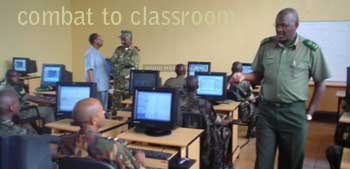Multisource political news, world news, and entertainment news analysis by Newsy.com
The National Survey of Student Engagement interviewed nearly 11,000 veterans and the results point fingers at universities.
BY CHRISTINE SLUSSER
From the warfront…to the classroom.
The transition might not be going as smoothly as it could — or should. That’s the findings of a new study of 11,000 veterans. We’re breaking down the research from The Washington Post, Inside Higher Ed, Army Times and Marketwire.
First to the study, done by The National Survey of Student Engagement. It interviewed thousands of veterans who were either first-year or senior students at four-year schools. The survey showed veterans were less likely to participate in study abroad programs or interact with professors and fellow students. The Student Veterans of America’s Michael Dakduk tells the Washington Post, some of the blame falls on universities.
 “Transitioning from military life to civilian life is difficult enough, but trying to fit in on a college campus is ‘a culture shock that’s hard to adjust to.’”
“Transitioning from military life to civilian life is difficult enough, but trying to fit in on a college campus is ‘a culture shock that’s hard to adjust to.’”
…but being less engaged doesn’t mean veterans are doing less work. The veterans in the survey were predominately male and many were first-generation college students.
But, Inside Higher Ed reports the veterans said they felt like they had less support on campus than other students not connected to the military. But there was also an upside.
“Military veterans attending four-year colleges… spend more time working at jobs and caring for dependents…but spend just as much time studying. And while the veterans appear to be less academically engaged…they are just as likely to report overall satisfaction with their college experiences.”
For those veterans already enrolled in college, ‘fitting in’ may be the least of their worries. With increasing tuition costs, even veterans using the Post-9/11 GI Bill, which pays for all or part of a veterans college tuition, could see more out-of-pocket costs.
“Student veterans in Minnesota attending private colleges where tuition and fees exceed the state caps, for example, are seeing maximum credit hour charges that are 40 percent below the fall 2009 term, a decline that could reduce VA payments by as much as $7,000 for full-time students.” (Army Times)
That’s not great news – But with Veteran’s Day just around the corner, help has arrived for some of these issues… in California at least. According to MarketWire, there is help out there even for veterans who aren’t in college.
“For many veterans, making the transition back to civilian life is hard, and finding a new job in today’s labor market is even harder… JVS Los Angeles developed Veterans First, which offers free career coaching, assessments to help identify transferable skills, job placement and even a Veterans Job Club support group.”
So what do you think causes veterans the disconnect in college? What can be done to help?
Visit Newsy.com – Multiple Sources, the Real Story
ATTENTION READERS
We See The World From All Sides and Want YOU To Be Fully InformedIn fact, intentional disinformation is a disgraceful scourge in media today. So to assuage any possible errant incorrect information posted herein, we strongly encourage you to seek corroboration from other non-VT sources before forming an educated opinion.
About VT - Policies & Disclosures - Comment Policy



